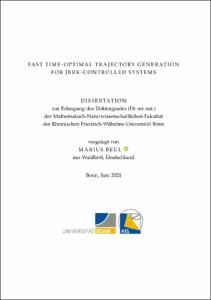Beul, Marius: Fast Time-optimal Trajectory Generation for Jerk-controlled Systems. - Bonn, 2022. - Dissertation, Rheinische Friedrich-Wilhelms-Universität Bonn.
Online-Ausgabe in bonndoc: https://nbn-resolving.org/urn:nbn:de:hbz:5-65406
Online-Ausgabe in bonndoc: https://nbn-resolving.org/urn:nbn:de:hbz:5-65406
@phdthesis{handle:20.500.11811/9616,
urn: https://nbn-resolving.org/urn:nbn:de:hbz:5-65406,
author = {{Marius Beul}},
title = {Fast Time-optimal Trajectory Generation for Jerk-controlled Systems},
school = {Rheinische Friedrich-Wilhelms-Universität Bonn},
year = 2022,
month = feb,
note = {Trajectory generation plays a central role in the quest to enhance the capabilities and performance of all kinds of robots.
Current state-of-the-art trajectory generation methods are either not time-optimal, need extensive computational recourses, or produce trajectories that need to satisfy assumptions like symmetric state constraints, restricting the possible field of applications.
This thesis proposes a computationally efficient method to generate smooth, dynamically feasible, time-optimal, third-order trajectories from arbitrary start- to arbitrary target-states. Trajectories comply with asymmetric state- and input constraints and can successfully handle initial states that lie outside of the allowed state space and return inside the bounded space by following different strategies. Trajectories for an arbitrary number of axes can be generated simultaneously, and three different approaches can temporally synchronize them. Our approach can also target partially defined target states, exploiting the undefined Degrees of Freedom (DoFs) to speed up the trajectory. Synchronized trajectories targeting incompletely defined target states can either maximize or minimize the free DoFs. Our method can estimate and actively compensate global acceleration biases, thus enhancing the disturbance rejection capabilities. Besides third-order trajectories, our approach can also generate second- and first-order trajectories, widening the field of possible applications. By exploiting the asymmetric boundaries, we introduce a technique to optimally intercept moving waypoints. By utilizing the ability to target partially defined target states, we generate optimal avoidance trajectories around a single rectangular moving obstacle in real-time. Our approach is extended to efficiently generate collision-free trajectories in complex scenarios. Multiple alternative trajectories are generated, checked for collisions, and, subsequently, the best collision-free alternative is selected and executed.
We evaluate our approach in simulation as well as on a variety of flying robots in real-world applications. Due to the fast runtime of our method, it is not only used to generate trajectories on a high level but to aggressively and precisely control nine different Unmanned Aerial Vehicles (UAVs), ranging from 3.0–11.2 kg in a closed loop.},
url = {https://hdl.handle.net/20.500.11811/9616}
}
urn: https://nbn-resolving.org/urn:nbn:de:hbz:5-65406,
author = {{Marius Beul}},
title = {Fast Time-optimal Trajectory Generation for Jerk-controlled Systems},
school = {Rheinische Friedrich-Wilhelms-Universität Bonn},
year = 2022,
month = feb,
note = {Trajectory generation plays a central role in the quest to enhance the capabilities and performance of all kinds of robots.
Current state-of-the-art trajectory generation methods are either not time-optimal, need extensive computational recourses, or produce trajectories that need to satisfy assumptions like symmetric state constraints, restricting the possible field of applications.
This thesis proposes a computationally efficient method to generate smooth, dynamically feasible, time-optimal, third-order trajectories from arbitrary start- to arbitrary target-states. Trajectories comply with asymmetric state- and input constraints and can successfully handle initial states that lie outside of the allowed state space and return inside the bounded space by following different strategies. Trajectories for an arbitrary number of axes can be generated simultaneously, and three different approaches can temporally synchronize them. Our approach can also target partially defined target states, exploiting the undefined Degrees of Freedom (DoFs) to speed up the trajectory. Synchronized trajectories targeting incompletely defined target states can either maximize or minimize the free DoFs. Our method can estimate and actively compensate global acceleration biases, thus enhancing the disturbance rejection capabilities. Besides third-order trajectories, our approach can also generate second- and first-order trajectories, widening the field of possible applications. By exploiting the asymmetric boundaries, we introduce a technique to optimally intercept moving waypoints. By utilizing the ability to target partially defined target states, we generate optimal avoidance trajectories around a single rectangular moving obstacle in real-time. Our approach is extended to efficiently generate collision-free trajectories in complex scenarios. Multiple alternative trajectories are generated, checked for collisions, and, subsequently, the best collision-free alternative is selected and executed.
We evaluate our approach in simulation as well as on a variety of flying robots in real-world applications. Due to the fast runtime of our method, it is not only used to generate trajectories on a high level but to aggressively and precisely control nine different Unmanned Aerial Vehicles (UAVs), ranging from 3.0–11.2 kg in a closed loop.},
url = {https://hdl.handle.net/20.500.11811/9616}
}






